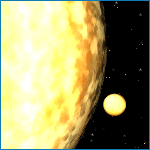

The Galactic position and direction of Polaris relative to Earth's Sun. Note that, at this extreme scale, the two stars are effectively in the same place.
The famous Pole Star lies less than one degree from the Northern Celestial Pole, and so always lies northward from an Earth-bound observer's point of view. Its name comes from Latin, Stella Polaris, meaning simply 'Pole Star'. Its alternative and much rarer name, Cynosura, comes from the Greek for 'tail of the dog'.
|
|